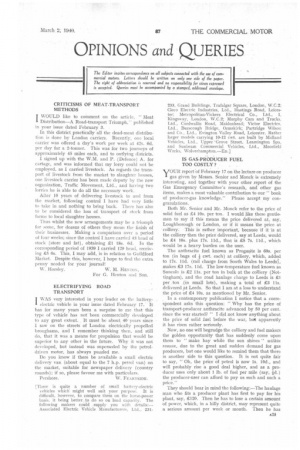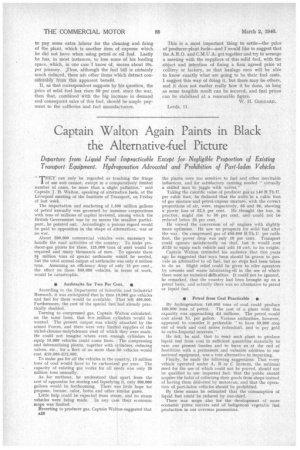OPINIONS and QUERIES The Editor invites correspondence on all subjects
Page 35

Page 36

If you've noticed an error in this article please click here to report it so we can fix it.
connected with the use of commercial motors. Leiters should be written on only one side of the paper. The right of abbreviation is reserved and no responsibility for views expressed is accepted. Queries must be accompanied by a stamped, addressed envelope.
CRITICISMS OF MEAT-TRANSPORT METHODS WOULD like to comment on the article, "Meat I Distribution—A Road-transport Triumph," published in your issue dated February 3.
In this district practically all the dead-meat distribution is done by London carriers. Recently, one local carrier was offered a day's work per week at 42s. 6d. per clay for a 2-tonner. This was for two journeys of approximately 45 miles each, and to outlying districts.
I signed up with the W.M. and P. (Defence) A. for cartage, and was informed that my lorry could not be employed, as I carried livestock. As regards the transport of livestock from the market to slaughter houses, one livestock carrier has been made deputy by the new organization, Traffic Movement, Ltd., and having two lorries lie is able to do all the necessary work.
After 16 years of delivering livestock to and from the market, following control I have had very little to take in and nothing to bring back. There has also to be considered the loss of transport of stock from farms to local slaughter houses.
Thus whilst the new arrangements may be a triumph for some, for dozens of others they mean the finish of their businesses. Making a comparison over a period of four weeks; since the control I have carried 43 head of stock (store and fat), obtaining 21 18s. 6d. In the corresponding period of 1939 I carried 129 head, receiving £5 (is. This, I may add, is in relation to Guildford Market. Despite this, however, I hope to find the extra penny needed for your journal!
W. Horsley. . W. M. HEN TON, For G. Henton and Son.
ELECTRIFYING ROAD TRANSPORT
I WAS very interested in your leader on the battery electric vehicle in your issue. dated February 17. It has for many years been a surprise to me that this type of vehicle has not been commercially developed to any great extent. . It must be about. 40' years since I saw on the streets of London electrically propelled broughams, and I rememberthinking then, and still do, that it was a means -for propulsion that would be superior to any other in the future. Why it was not developed, but instead was superseded by the petroldriven motor, has always puzzled me.
Do you know if there be available a small electric delivery van (about equal to the 7 h.p. petrol van) on the market, suitable for newspaper delivery (country rounds); if so, please favour me with particulars.
Perstiore. W. Fa A R NSIDE
[There is quite a number of small battery-electric vehicles which. might well suit your purpose. It is difficult, however, to compare them on the horse-power basis, it being better -to do so on load capacity. The following makers could supply you with details:— Associated Electric Vehicle Manufacturers, Ltd., 231 233, Grand Buildings, Trafalgar Square, London, W.C.2; Cleco Electric Industries, Ltd., Hastings Road, Leicester; Metropolitan-Vickers Electrical Co., Ltd., 1,
• Kingsway, London, W.C.2; Murphy Cars and Trucks, Ltd., Cordwallis Road, Maidenhead; Victor Electrics, Ltd., Burscough Bridge, Ormskirk; Partridge Wilson and Co., Ltd., Evington Valley Road, Leicester. Rather larger models carrying 10-12 cwt. are built by Midland Vehicles, Ltd., Upper °Grove Street, Leamington Spa. and Sunbeam Commercial Vehicles, Ltd., lsIoorfieId Works, Wolverhampton.—ED.1
IS GAS-PRODUCER FUEL TOO COSTLY?
yOUR report of February 17 on the lecture on producer gas given by Messrs. Senior and Monck is extremely interesting, and together with your other report of the Gas Emergency Committee's research, and other gas items, makes a most valuable conteibution to our" book of producer-gas knowledge." Please accept my congratulations.
Both Mr. Senior and Mr. Monck refer to the price of solid fuel as £4 10s. Per ton. I would like these gentlemen to say if this means the price delivered at, say, Loughborough or London, or if it means the price at colliery. This is rather important, because if it is at the colliery then the price delivered, say at Leeds, would be £4 10s. plus 17s. lid., that is £5 7s. 11d., which would be a heavy burden on the user.
The anthracite fuel known as Pmgasite is 60s. per ton (in bags of cwt. each) at colliery, which, added to 17s. Ild. (rail charge from South Wales to Leeds, makes £3 17s. lid. The low-temperature fuel known as Suncole is £2 1 ls. per ton in bulk at the colliery (Nottingham), and the road haulage charge to Leeds is £1 per, ton (in small lots), making a total of £3 1 ls. delivered at Leeds. So that I am at a loss to understand the price of £4 10s. as mentioned by Mr. Senior.
In a contemporary publication I notice that a correspondent asks this question: " Why has the price of transport-producer anthracite advanced by 50 per cent. Since the war started? " I did not know anything about the price of solid fuel before the war, but apparently it has risen rather seriously.
Now, no one will begrudge the colliery and fuel makers the golden opportunity that has suddenly come upon them to "make hay while the sun shines" within reason, due to the great and sudden demand for gas producers, but one would like to remind them that there is another side to this question. It is not quite fair to say, "Oh, the price of petrol is now Is. 10d., and will probably rise a good deal higher, and as a producer uses only about 1 lb. of fuel per mile (say, id.) the producer-user can afford to pay us such and such a price."
They should bear in mind the following:—The haulage man who fits a. producer plant has first to pay for his plant, say, £120. Then he has to lose a certain amount of power, which, in a hilly district, may represent quite a serious amount per week or month. Then he has
to pay some extra labour for the cleaning and firing of the plant, which is another item of expense which he did not have when using petrol or oil fuel. Lastly he has, in most instances, to lose some of his loading space, which, in one case I know of, means about 10s. per journey. ,Thus, although the fuel bill is certainly much reduced, there are other items which detract considerably from this apparent benefit.
If, as that correspondent suggests by his question, the price of solid fuel has risen 50 per cent. since the war, then that, combined with the big increase in demand and consequent sales of this fuel, should be ample payment to the collieries and fuel manufacturers.
This is a most important thing to settle—the price of producer-plant fuels—and I would like to suggest that -the A.R.O. and C.M.U.A. get together and try to arrange a meeting with the suppliers of this solid fuel, with the object and intention of fixing a firm agreed price at colliery or factory, so that haulage men will be able to know exactly what are going to be their fuel costs. I suggest this way of doing it, but there may be others, and it does not matter really how it be done, as long as some tangible result can be secured, and fuel prices can be stabilized at a reasonable figure.
W. H. GODDARD. Leeds, 11.




































































